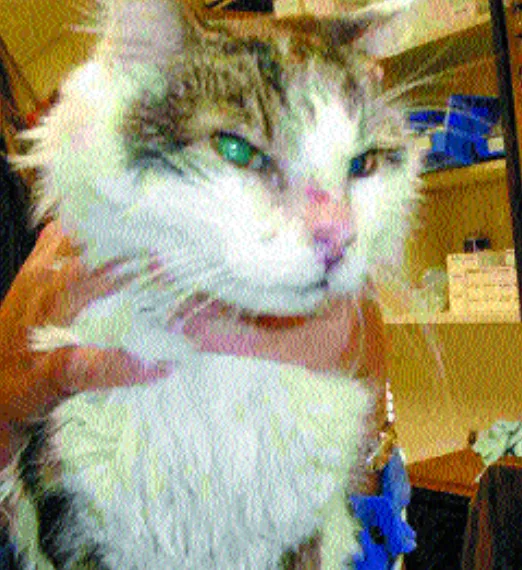Methimazole Reaction in a Cat
Deborah S. Greco, DVM, MS, PhD, Animal Medical Center, New York, New York

A 12-year-old male, castrated, domestic longhair presented for suspected upper respiratory infection.
History
The cat was diabetic, hyperthyroid, and currently receiving 2 units of PZI Q 12 H and 5 mg methimazole Q 12 H PO for the past 2 months. The owners reported that the cat started scratching its face and nose about 1 week previously.
Physical Examination
Mild ocular discharge and facial excoriations on the pinnae and nasal planum were noted on physical examination. No coughing or sneezing was evident. The cat is current on vaccines, and there are no new pets in the household.
Table 1: Diagnostic Testing*
Table 2: Diagnostic Testing*
† Low ‡ High
* ALP = alanine phosphatase; ALT = alanine aminotransferase; AST = aspartate transaminase; BUN = blood urea nitrogen; FT4D = free thyroxine by equilibrium dialysis; GGT = gamma-glutamyltransferase; RBC = red blood cell; TT4 = total thyroxine; WBC = white blood cell
Ask Yourself ...
What is the first step in treatment?
What other treatment options for hyperthyroidism might be considered?
What side effects are associated with antithyroid agents?
What are the potential complications of thyroid treatment?
Diagnosis: Idiosyncratic reaction to methimazole
The drug was discontinued, and the owners elected I131 treatment for the hyperthyroidism. The diabetes was secondary to hyperthyroidism; thus, the cat was no longer insulin-dependent after permanent resolution of the hyperthyroidism through iodine therapy. Renal function remained stable, and the owners were pleased with the resolution of clinical signs.
Did You Answer ...
Discontinue the methimazole.
Propylthiouracil, iopanoic acid, surgery, or radioactive iodine. Dexamethasone, β-adrenergic blocking agents, dextrose, and thiamine may be helpful for thyroid storm.
Anorexia and vomiting are common; pruritus of the face, thrombocytopenia, bleeding diathesis, agranulocytosis, serum antinuclear antibodies, and hepatopathy (jaundice) are rare.
Renal disease can result from all forms of therapy - medical, surgical, and iodine.
Drug Reactions
This is an example of a non-dose-dependent, idiosyncratic drug reaction; this type of reaction to methimazole and propylthiouracil is uncommon. Drug reactions, or "allergies," can manifest as cutaneous lesions (facial erythema), hematologic abnormalities (neutropenia and thrombocytopenia), or liver disease (cholangiohepatitis). All of the abnormalities in this patient could be attributed to an idiosyncratic reaction to methimazole. Therapy requires discontinuation of the drug because the reaction is non-dose-dependent, or "allergic."
Medical Therapy
Medical options for treating feline hyperthyroidism include methimazole, propylthiouracil, and iopanoic acid. Advantages of medical therapy include low initial cost as well as availability and reversibility of treatment. Disadvantages are the potential for iatrogenic hypothyroidism; exacerbation of renal disease; and side effects that can include leukopenia, drug eruption resulting in facial pruritus, and cholangiohepatitis. Most cats are medically managed with methimazole at 5 mg twice daily; however, many cats can be successfully treated with 2.5 to 5 mg once daily or every other day if side effects occur.
Propylthiouracil is rarely used because of the potential for blood dyscrasias, but it is prescribed for thyroid storm to peripherally inhibit conversion of T4 to T3. Iopanoic acid is an experimental drug that replaces ipodate, which is no longer available in the U.S. and had been described as an alternative to methimazole therapy. However, these agents do not lower T4 but prevent peripheral conversion of T4 to T3. Serum T3 must be measured rather than serum TT4. Other drugs that may be helpful in the medical treatment of hyperthyroidism, particularly thyroid storm, include dexamethasone (inhibits peripheral conversion of T4 to T3), β-adrenergic blocking agents (atenolol, 6.25 mg Q 24 H), 5% dextrose, and thiamine. Hypertension should be treated, if present, with amlodipine (0.625 mg PO Q 24 H). After hypertension has been corrected, hypertension therapy should be tapered while blood pressure is reassessed. In most cats, effective treatment of hyperthyroidism results in correction of hypertension.
Precautions for Use of Antithyroid Agents
Antithyroid drugs are associated with several adverse effects; for example, methimazole commonly causes anorexia and vomiting. Rare reactions include self-induced excoriation of the face, thrombocytopenia, bleeding diathesis, agranulocytosis, serum antinuclear antibodies, and hepatopathy. These side effects usually develop within the first 3 months of treatment and whether to stop and choose an alternative treatment depends on severity. Bleeding, jaundice, and agranulocytosis are indications for immediate withdrawal.
Patient Monitoring
A physical examination, CBC (with platelet count), serum biochemical analysis, and serum T4 determination should be done every 2 to 3 weeks for the initial 3 months of treatment. The dose of methimazole should be adjusted to maintain serum T4 concentration in the low-normal range. Glomerular filtration rate declines after hyperthyroidism treatment in most patients. Therefore, to monitor renal function, a physical examination, serum biochemistry tests, and urinalysis should be done 1 month after treatment and then as indicated by the clinical history.
Complications of Therapy
Renal disease may be observed following any rapid reversal of the hyperthyroid state. All forms of therapy, including medical, surgical, or treatment with I131, can result in deterioration of renal function. When the decline occurs in conjunction with medical therapy, the drug can be discontinued or its dose reduced to support renal function by allowing the TT4 to remain in the upper range of normal. If permanent treatment of hyperthyroidism is desired, pretreatment with methimazole is recommended to determine whether the cat will tolerate continuous therapy. The prognosis for uncomplicated cases of hyperthyroid disease is excellent. Recurrence is possible and is most commonly the result of poor owner compliance. Regrowth of hyperthyroid tissue can occur but is uncommon after surgical thyroidectomy or radioiodine treatment.